| Designation: | YPR 765 |
 |
|---|---|---|
| Manufacturer: | BAE Systems Land and Armament | |
| Product type: | Armoured Vehicles | |
| Name: | Infantry fighting vehicle |
The YPR-765 is a tracked armoured vehicle in use by The Royal Netherlands Army. The Royal Netherlands Army has some 1600 vehicles in different versions.
At the infantry for troop transport and at the cavalry for reconnaissance. The YPR-765 is currently used on the Dutch operation in Uruzgan, Afghanistan.
The vehicle will be replaced by 184 CV-9035 vehicles (from the Swedish company Hägglunds), 400 reconnaissance type Fennek and 200 Boxer vehicles. The Egyptian Army will buy 431 YPR-765 vehices from The Netherlands.
In 1967, under contract to the US Army, the then Ordnance Division of the FMC Corporation (today BAE Systems, Ground Systems Division) built two MICVs under the designation XM765. These were based on the proven M113 APC modified to incorporate firing ports and a fully enclosed one-person weapon station.
Further development of the XM765 by the company as a private venture resulted in the Product Improved M113A1, the first prototype of which was completed in 1970. This had a fully enclosed weapon station in the centre of the hull, behind the driver and engine, and the commander's cupola to the rear of the turret.
This arrangement gave the commander very little forward vision so the vehicle was redesigned with the commander sitting behind the driver on the left and the turret to the rear of the engine on the right. This vehicle was subsequently called the Armored Infantry Fighting Vehicle.
The first country to order the AIFV was the Netherlands that eventually placed orders for a total of 2,079 vehicles in two batches: one of 1,264 that was co-production with the then FMC Corporation and the second for 815 vehicles, which was local production with a number of companies in the Netherlands.
The second order of 815 vehicles included 119 in the Improved TOW Vehicle configuration. Daf Special Products was involved in the production and final assembly of these vehicles.
The Philippines received 45 AIFVs. In July 1979, Belgium placed an order for 514 AIFVs and 525 M113A2s to be built under licence in Belgium by Belgian Mechanical Fabrication to replace M75 and AMX VCIs in service with the Belgian Army. First production vehicles were completed in 1982 and production ran at the rate of 20 to 25 vehicles (AIFV and M113A2) a month until May 1988.
Following an international competition in 1989, the now BAE Systems, Ground Systems Division AIFV was selected by Turkey to meet its future operational requirements and additional details of this programme are given in a separate entry. The first production batch consisted of 1,698 vehicles, which have now been delivered.
The first 285 hulls for the Turkish programme were built in Belgium by Cockerill Mechanical Industries. They then shipped the necessary tooling and equipment to Turkey to enable the remainder of the order to be built in Turkey by FNSS Defence Systems (which is now called FNSS Savunma Sistemleri).
After about 200 vehicles had been built and delivered to the Turkish Land Forces, the company was asked to incorporate a more modern power pack and improved steering capability, based on the latest M113A3 improvements.
The remaining vehicles, referred to as the Armoured Combat Vehicle 300 (ACV 300), were equipped with a 300 hp Detroit Diesel engine coupled to an Allison X400-B transmission.
In 2000, the Turkish Land Forces Command placed another order for an additional 551 armoured personnel carrier vehicles with an option for another 115. FNSS commenced production in 2001, with the first 14 delivered in January 2002.
In 1998 the United Arab Emirates ordered 133 vehicles in three configurations, Armoured Recovery Vehicle (ARV), Armoured Engineering Squad Vehicle (AESV) and Armoured Artillery Forward Observation Vehicle (AAFOV). As a further enhancement, the UAE requested a 350 hp engine. All of these vehicles have now been delivered and are referred to as the ACV 350.
In 2001, FNSS Savunma Sistemleri received an order from Malaysia for 233 ACV 300 in 10 different versions. In addition to the ACV with the Sharpshooter turret, the company delivered two variants with Thales turrets as well as recovery, fitter, mortar, command post, anti-armour, signals and ambulance. Deliveries commenced early in 2002 and were completed in 2004.
The AIFV has also been tested in Pakistan but no production has yet been undertaken in this country. Pakistan has developed a vehicle along similar lines, which is called the Talha. Details of the Talha are given in a separate entry under Pakistan.
In January 1993, the Royal Netherlands Army announced substantial cuts including the phasing out of 336 of the AIFV (YPR 765) infantry fighting vehicles and 201 YPR 765 PRATs with the TOW ATGW system. In addition, all M113 series vehicles would be phased out of service.
In mid-1994, the Netherlands stated that Egypt was to purchase a total of 611 AIFVs and variants under a contract worth USD150 million. All of these were delivered by the end of 1996 in the following versions:
304 YPR 765 PRI AIFVs
6 YPR 765 PRCO-B command post vehicles
210 YPR 765 PRAT-TOW anti-tank vehicles
79 YPR 765 PRCO-C command post vehicles
12 M577A1 command post vehicles (these are not actually based on the AIFV chassis being a member of the M113 family of armoured personnel carriers).
In early 2005 it was stated that another 431 YPR 765 series APCs were to be provided by the Netherlands, with first deliveries in mid-2005. This brought the total Egyptian fleet to 1,042 units.
The hull of the AIFV is made of welded aluminium armour with an additional layer of spaced laminate steel armour bolted onto the hull. Closed cell polyurethane foam within the armour system gives increased buoyancy for amphibious operations.
The driver sits at the front of the hull on the left and has a single-piece hatch cover that opens to the right. To the front and left side of his position are four M27 day periscopes, the centre one of which can be replaced by a passive periscope for driving at night.
The commander sits to the rear of the driver under a cupola, which can be rotated through a full 360°. It has a single-piece hatch cover that opens to the rear and five day periscopes, four standard M17 day periscopes and a day periscope with a magnification of ×1 and ×6.
In the Dutch, Belgian, Filipino and first 200 Turkish versions, the diesel engine is to the right of the driver and coupled to the three-speed automatic transmission by a transfer gear case.
The complete power pack can be removed through a front hatch, which is fitted with a door for daily maintenance tasks.
Normal steering and braking are by oil-cooled band-type brakes in the controlled differential. There is a set of air-cooled disc brakes on the differential output shafts for low-speed tight turns on land and for more efficient manoeuvring in the water. A large radiator and belt-driven high-capacity fan mounted in the top of the engine compartment provide cooling to normal high-ambient temperature limits.
The power train is similar to the M113A1's except for improved features such as the engine turbocharger, larger capacity radiator, transmission modified with heavy-duty components, heavy-duty universal joints and final drives as fitted to the now BAE Systems, Ground Systems Division M548 tracked cargo carrier.
On the first 200 Turkish vehicles the cooling system differs from the Dutch, Belgian and Filipino AIFVs in that it is the same as that of the M113A2. In the Turkish versions of the AIFV, after the first 200 vehicles, the Detroit Diesel 6V-53T 300 hp turbocharged diesel engine sits to the right of the driver and is coupled to an Allison X-200-4 four-speed automatic transmission. This is similar to the M113A3 power pack but at a higher power level. The transmission provides four forward speeds, reverse, and hydrostatic steering. The cooling system has been modified with a larger radiator and improved fan to provide improved cooling as compared to the older AIFVs and M113A3s. These vehicles are now designated the ACV-300 family. The UAE vehicles are equipped with a 350 hp engine and are designated the ACV-350.
The Malaysian Infantry Fighting Vehicle is fitted with the Sharpshooter one-man electrically driven two-axis stabilised turret armed with a 25 mm M242 cannon and 7.62 mm FN MAG-58 7.62 mm machine gun. Fully enclosed weapon station is on the right side of the hull behind the engine. It is all-welded with an additional layer of spaced armour as fitted to the hull. The gunner has a single-piece hatch cover that opens to the rear and four M27 day periscopes (two either side). In the original Belgian and Dutch vehicles a Philips sight with a magnification of ×2 or ×6 for day use and ×6 for night use is installed. In the Netherlands the Philips sights have been replaced with thermal sights produced by Oldelft. For Turkey, thermal sights have also been installed.
Main armament consists of an Oerlikon Contraves 25 mm KBA-B02 cannon with dual feed, which has 180 rounds of ready use ammunition and another 144 rounds in reserve. Mounted coaxial to the left of the main armament is an FN MAG-58 (US M240C) 7.62 mm machine gun with 230 rounds of ready use ammunition and a further 1,610 rounds in reserve in the hull (Turkish vehicles have a 7.62 mm MG3 machine gun built under licence by MKEK). Turret traverse and gun elevation are electrohydraulic, elevation is from -10 to +50° at a speed of 60°/s and turret traverse is through a full 360° at 60°/s. Dutch vehicles also have six 76 mm electrically operated smoke grenade launchers mounted on the front of the hull.
The troop compartment at the rear of the hull accommodates seven seated infantry. One man sits between the commander and the turret facing the rear and the remaining six sit three each side, back-to-back. In the Turkish AFV and AAPC versions, the troop compartment accommodates 10 seated infantry. One man sits between the commander and turret facing the rear, seven are seated on bench seats at the side of the vehicle facing inwards and two are seated on jump seats facing the rear. Over the top of the troop compartment is a single-piece hatch cover that opens to the rear and contains the troop compartment ventilator. There are five firing ports, two in each side of the hull and one in the ramp at the rear. Over each of the side firing ports is an M17 day periscope and over the rear firing port an M27 day periscope. To reduce accidental damage inside the vehicle, holders support the individual weapons during firing. Spent brass catching bags prevent ejected cartridge cases from hitting adjacent men.
The infantrymen enter and leave the vehicle by a power-operated ramp which opens downwards at the rear of the hull. An emergency door is provided in the left side of the ramp.
The two armoured diesel fuel tanks at the rear of the vehicle, one either side of the ramp, are separated from the vehicle interior by armour plate.
The torsion bar-in-tube spring arrangement, which almost doubles the effective length of the torsion spring, gives a much improved ride compared with the M113A1 APC. The track, road wheels and most of the other suspension elements are identical to the M113A1's. The suspension either side consists of five dual rubber-tyred road wheels with the drive sprocket at the front and the idler at the rear. There are no track-return rollers. The first, second and last road wheel stations either side have a hydraulic shock-absorber. The track is a T130E1 steel block, rubber-bushed pin type with removable rubber pads.
Due to advances in metallurgy, the Belgian and Turkish AIFVs use torsion bar only suspension, similar to the M113A2, to achieve the same results as the older AIFV bar-in-tube springs.
The Belgian and Turkish vehicles are fitted with NBC systems with clean air provided individually to each person. All AIFVs are fitted with a personnel heater.
The ACV 350s delivered to the UAE and the ACV 300s supplied to Malaysia, are both fitted with an air conditioning system and over pressure NBC system. All of these have now been delivered.
The AIFV is fully amphibious and is propelled in the water by its tracks. Before entering the water a trim vane, which is stowed flat on the glacis plate when not in use, is erected at the front of the hull.
The Belgian Army took delivery of a 525 AIFV and M113A1 series vehicles under a contract placed with the now BAE Systems, Ground Systems Division in April 1980. These were built under licence by Belgian Mechanical Fabrication with deliveries running from 1982 through to 1988.
The following AIFV versions were supplied - AIFV with turret mounted 25 mm cannon, AIFV with .50 (12.7 mm) cupola weapon station and AIFV command post.
M113A1 versions included anti-tank with MILAN ATGW, driver training, engineer, command post, recovery, maintenance with crane, ambulance, forward air control, maintenance, radar carrier and mortar tractor.
The Belgian AIFV and M113A1 series are being replaced by Swiss MOWAG Piranha IIIC (8 × 8) vehicles with a total of 242 units to be supplied from 2007 onwards.
Belgium has already started to offer these surplus AIFV and M113A1 on the export market. According to the United Nations, in 2005 Belgium exported the following vehicles:
10 × M113 series APC to Jordan
3 × YPR 765 APC to Jordan
13 × YPR 765 25 mm to Jordan
45 × YPR 765 with MILAN launcher to Jordan
The basic AIFV is designated the YPR 765 PRI by the Royal Netherlands Army and variants originally fielded included the following:
YPR 765 PRCO-B command vehicle, crew nine, combat weight 13,700 kg.
YPR 765 PRCO-C1 to C5, crew nine, combat weight 12,400 kg, armed with a .50 (12.7 mm) M2 machine gun. The C1 is a battalion commander's vehicle, C2 a battalion gunnery centre, C3 a mortar fire-control vehicle, C4 an anti-aircraft command vehicle and C5 an observation vehicle with a crew of four. All these versions have an M113-type cupola with a .50 (12.7 mm) M2 HB pintle-mounted machine gun. The YPR-765 PRCO-3 is no longer used by the Royal Netherlands Army. The C3 designator is now used by the combat engineer command vehicle YPR-765 PRCGN-C3. This stands for Pantser Rups Commando, Genie.
YPR 765 PRRDR radar vehicle fitted with the UK ZB 298 battlefield surveillance radar.
YPR 765 PRRDR-C radar/command vehicle.
YPR 765 PRGWT ambulance, crew four, weight 11,600 kg, unarmed.
YPR 765 PRI/I squad vehicle fitted with M113-type cupola with a .50 (12.7 mm) M2 machine gun, carries nine men plus driver.
YPR 765 PRMR mortar tractor (tows 120 mm TDA mortar), crew seven, combat weight 13,000 kg, armament one .50 (12.7 mm) M2 machine gun pintle-mounted on a standard M113-type cupola.
YPR 765 PRVR-A and PRVR-B cargo vehicles, crew two, combat weight 13,400 kg, armament one .50 (12.7 mm) M2 machine gun pintle-mounted on a standard M113-type cupola.
YPR 765 PRAT fitted with the Systems & Electronics Inc TOW launcher system as fitted to the M901 Improved TOW Vehicle. The PRAT (Pantser Rups Anti-Tank) entered service with the Royal Netherlands Army in 1982 and has a crew of four.
YPR 806 PRBRG armoured recovery vehicle, crew four, weight 12,200 kg, armament one .50 (12.7 mm) M2 machine gun. Details of this model are given later in this entry.
With the addition of a variety of kits, the basic AIFV Universal Vehicle Chassis can be converted to the following roles:
This has revised seating arrangements for a command staff of six plus its crew of three (commander, gunner and driver), and is fitted with additional communications equipment, a table and a stowage rack for .50 (12.7 mm) ammunition. It is normally armed with a .50 (12.7 mm) M2 HB machine gun on a pintle mount.
This tows a 120 mm TDA or similar mortar and has racks at the rear of the troop compartment on the right side for 51 mortar bombs. A crew of seven is normally carried, three vehicle crew plus four mortar crew. It is normally armed with a .50 (12.7 mm) M2 HB machine gun on a pintle mount, but this can be replaced by an M26 weapon station fitted with a .50 (12.7 mm) M2 HB machine gun.
In addition to being fitted with the Systems & Electronics Inc ITV kit, other TOW installations are possible, and the vehicle can also be fitted with other types of ATGW system such as the HOT. All users with an anti-tank requirement have so far selected the ITV launching 3,750 m range Raytheon Systems Company TOW ATGW.
This model can carry up to 2,040 kg of cargo and has a crew of two, driver and gunner. Armament consists of a .50 (12.7 mm) M2 HB machine gun. The cargo kit includes protective grating behind the driver and gunner and tie-down devices to secure the load while travelling across country.
Four stretchers suspended from hanger harnesses are fitted in the troop compartment at the rear and two seats are provided for medical assistants. This model is unarmed.
This is similar to the XM806, which is a member of the M113A1 family, but the Dutch vehicles have grenade dischargers mounted on the front of the hull, an HIAB crane mounted on the roof and additional buoyancy pods attached to the hull sides. This vehicle features the same suspension and power train as the AIFV. The trim vane at the front of the hull also has an additional buoyancy attachment.
This is designated the YPR-765 KMAR (Koninklijke Marechaussee) and is a YPR-765 PRI/I with a number of modifications for use by the military police for intervention purposes.
Netherlands YPR-765 fleet was modified with additional stowage boxes and 3 tone NATO camouflage.
This is called the YPR-765GN (Genie) and is a support vehicle for engineer squads.
In 1979, the Philippines government procured 45 AIFVs, which have the same basic configuration as the Netherlands YPR 765 PRI vehicles. Although the enclosed weapon station was delivered ready to accept the Oerlikon Contraves 25 mm KBA-B02 cannon, a kit was developed to convert the station to accept a .50 (12.7 mm) M2 HB machine gun in its place. Six armoured recovery vehicles were also procured (see previous variant entry). The designation of the version with the 12.7 mm M2 machine gun is the PIFV.
|
||||||||||||||||||||||||||||||||||||||||||||||
|
|||||||||
|
|||||||||||||||||||||||||||
|
|||||||||||||||||||||||||||||||||||
All contracts...
Related Articles |
|
GM Outlines Possibilities for Flexible, Autonomous Fuel Cell Electric Platform (13.10.2017) |
|
DRS Defense Solutions Awarded $32.5 Million Contract for Integrated Vision Systems (IVS) for the U.S. Army ABV (09.03.2011) |
|
New camouflage arrives in Afghanistan (22.05.2010) |
|
CV90 Enters Service with Dutch Army (17.12.2008) |
|
Infantry Fighting Vehicle (29.01.2007) |
|
Stork and its partners receive the Boxer series production contract (25.12.2006) |
|
DRS Awarded $7m Electro-optical/infrared Sensors Contract for U.S. Army FCS UAV (30.11.2006) |
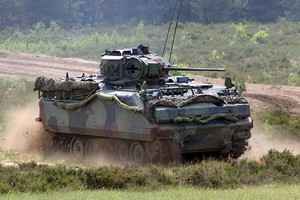 |
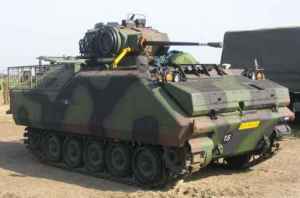 |
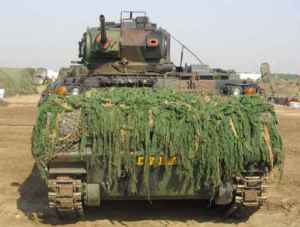 |
 |
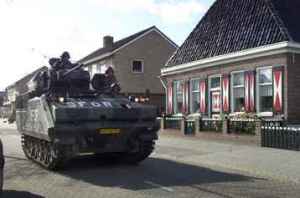 |
 |
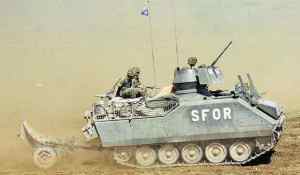 |
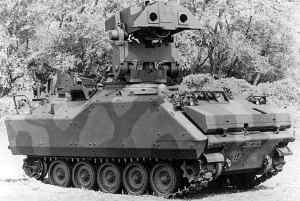 |
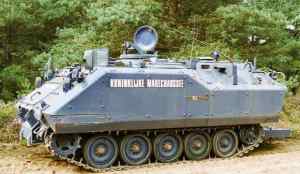 |
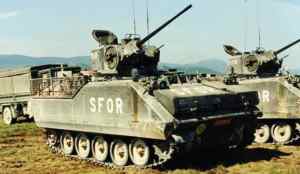 |
 |
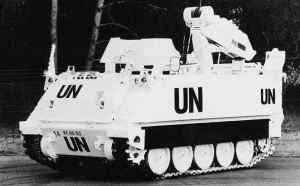 |






